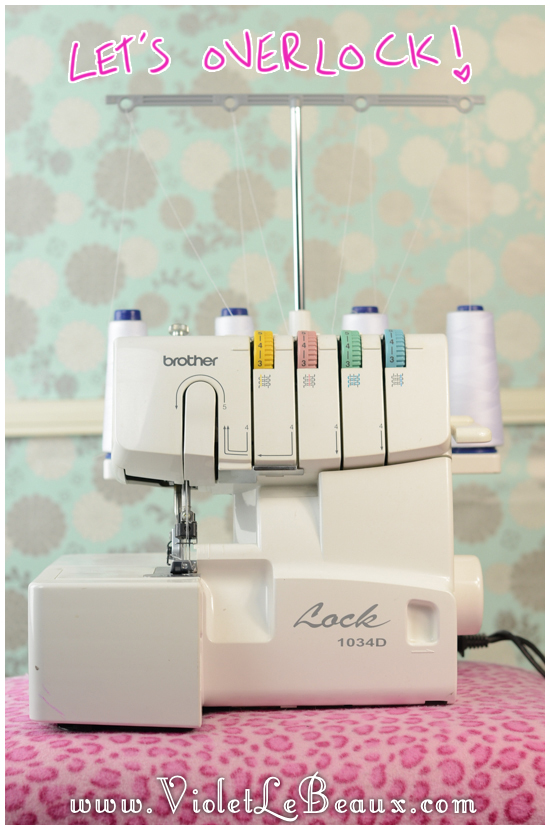Ok back into sewing this week and I think it’s time to learn about the other machine that some of your may or may not have: the overlocker (or serger if you’re in the USA).
|
So what is an overlocker? Basically it’s a big fat sewing machine which uses 3-4 threads and seals the raw edges of fabric. It usually has a little blade arm which cuts the edge of the fabric as you stitch along it so it makes a really neat perfect edge. The purpose is to seal edges so they don’t fray but also overlocked seams are neater and more sturdy because they have 2 lines of basic stitching and 4 threads rather than the 2 of a regular machine. The basic line of stitching that an overlocker creates is 2 regular lines of straight stitch with two other threads which zigzag between them and around front to back. Most of the time overlocking is hidden inside the garment but occasionally you can use an overlocker to create very tight visible stitches on unfolded hems. This is usually done of fabrics like chiffon where hems are a pain in the butt but also for visual effect on others. Have a look at the inside of one of your dresses, you’ll see thicker seams which are overlocked. So do you need one? If you’re planning on selling the clothes you make or want a really professional finish then I think it’s a great tool. It’s not 100% necessary but they are really good to have and I find them to save a lot of time. If you are wanting to save time you can always overlock fabric pieces together rather than edging each and then sewing together. Not technically “correct” in sewing theory but it saves a lot of time and effort! Overlockers are also more expensive, require more maintenance because they have a lot more moving parts and mechanics. They are harder to thread and generally harder to wrap your head around. That said if you put in the initial effort they are totally worth it. My machine cost around $600 in 2005, it was a birthday gift, it’s a “Lock 1034D” and I haven’t had it serviced it the 8 years I’ve had it (out of cost and laziness). It’s broken a few times since I’ve owned it but each time either James or I have been able to just take it apart and find the issue. Can’t complain!
I’m not really going to go into detail with the mechanics of threading an overlocker because each one is dramatically different but here is how mine works: Two of the threads are threaded through the two needles like you would a regular machine and then the other two are threaded inside the actual machine and come out under the foot. Close up it looks something like this: From the top it looks quite complicated but basically you have 4 spools of thread and then holder clips and tension wheels for each. On the side there is a handwheel, foot lift, air vent and power button. And then on the other side there are levers to control the stitches and the cutter. You machine will probably have completely different levers. Overlockers usually have a front panel which slides down to reveal the mechanics. The two underneath threads are threaded through a series of metal loops and little metal pull out pieces which push into place and thread the inside. Most modern overlockers actually have instructions colour coded on them so you can just follow the numbers to thread it. Be extremely careful when you are threading not to have your foot on the pedal. There are so many moving parts in there which could easily catch fingers!
So really the most important thing to do if you’re considering an overlocker is try them out in store to find one you like the feel of and make sure it comes with really thorough instructions. Most places that sell sewing machine offer free classes so you can get to know your new machine, they are definitely worth checking out if you have the time. My overlocker came with a VHS (which was completely outdated even then) instruction video and in this day and age a lot of companies have specific beginners videos on getting started. My top tips for working with your machine when you get it:
Hope this was a useful post and let me know if you have any questions and I’ll do my best to answer them next time! |














